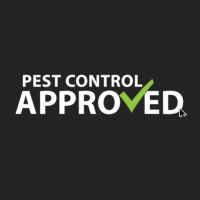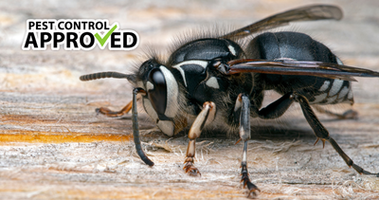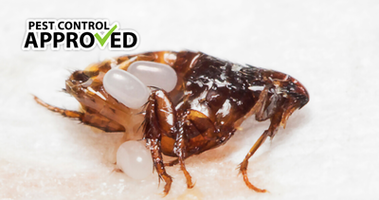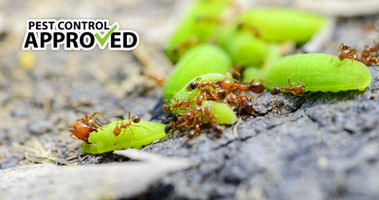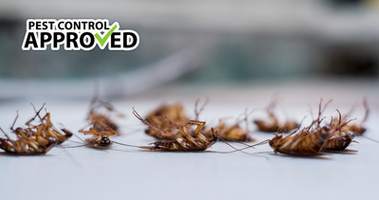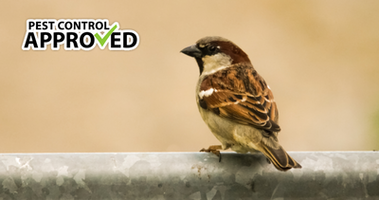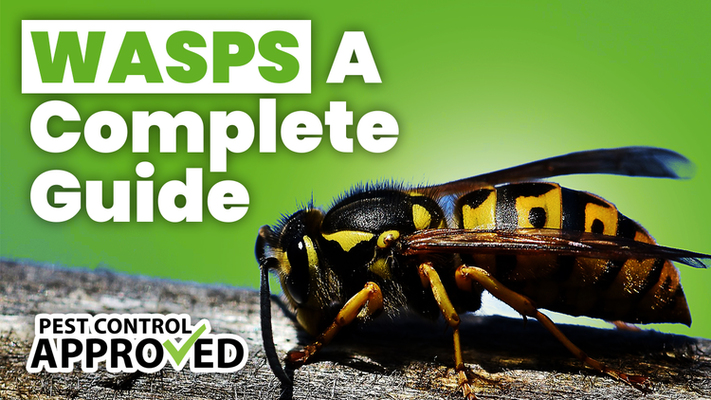
Wasps, What Are They?
Wasps are flying insects that are part of the superfamilies Sphecoidea or Vespoidia family. Not only can these insects bite, they also hold a painful sting that helps defend against predators and hunt for prey. Most Wasp species have stingers without barbs, this allows for the stinger to be easily removed, however the sting can be painful and cause severe allergic reactions.
Although most people are afraid of Wasps, they are considered to be a beneficial insect to farmers as they eat crop destroying pests like Grubs, Caterpillars, and Weevils. In some cases, farmers have been known to relocate Wasps closer to their crops to act as a form of Pest Control without the spraying of pesticides.
Wasps have 12 to 13 segments, with a pair of antennae, and a stinger on the end of their abdomen. Their stingers not only act as an effective defense mechanism, but also contain egg-laying organs for reproduction and colony growth.
Most species of wasps feed on small insects, however they can also feed on sweet secretions from their larva. Food sources all depend on what’s available, and the species of Wasp.
There are two primary groups of wasps, social and solitary. The most common Wasps found in the United States and Canada are Yellow-Jackets and Hornets. These species are part of the social group with colonies ranging from 100 to 5000+ individuals.
During a Wasps life cycle, they go through what’s called Metamorphosis. This means Wasps start as an Egg, and hatch into larva. After the larva stage, they turn into Pupae, also referred to as “The Resting Stage”. From here the Wasp then sheds its skin and enters the Adult stage, later turning into either male workers or future Queens.
Hornets Vs Yellow-Jackets
Although Hornets and Yellow-Jackets appear different in size and color, they both pack a painful sting that can be deadly depending on the victim’s allergic reaction. Wasps are generally smaller than Hornets, however Queen wasps can quickly grow depending on the time of year. In our experience, we have found Yellow-Jackets to be more aggressive when it comes to defending their nests. Once a Wasp is threatened, they emit a pheromone that notifies all other nearby Wasps to be on high alert, attacking anything in sight that moves. Check out our guide on How to Eliminate a Wasp Nest safely. When a nest can’t physically be seen and only the entry point is visible, its always best to contact a Local Pest Control Company to ensure no one gets hurt and the nest is removed properly.
Both Hornets and Yellow-Jackets are beneficial to humans as they are considered predatory insects, feeding on other nuisance insects that invade our homes and destroy crops. Because of this, it’s best to leave a Wasp Nest alone unless in direct threat of you and your family.
What is the difference between Hornets and Wasps?
- Hornets - Hornets are generally 1 to 1.5 inches long and build their nests in protected areas sheltered from high winds and rain, usually in tall trees with thick bushing. Their nests are often round in shape with the entrance at the base. Hornet nests can vary in size and consist of saliva and chewed up wood which results in a paper-like material. Colonies can range from a dozen, to several hundred in numbers. A Hornets nest size depends on many factors, such as competing food sources, nearby predators, and the nests location. Hornet and Wasp nests look similar, however the best way to tell the difference is the color of the insect. Hornets are black and white in color, and often much larger than their black and yellow relatives.
- Wasps - Wasps are smaller than hornets and often measure less than an ich in size. Like Hornets, Wasps build nests high up in trees with protection from weather elements, although most Wasp nest locations are built waist height or lower. These nests are commonly found under concrete steps, decks, sheds, barbecues, and many other areas out of site. Each nest can vary in size, some colonies left alone with a large amount of available food sources nearby can grow into several thousand workers.
Common types of wasps
Social Wasps
- Paper Wasps - These wasps forage for fibers from dead wood and plants to construct nests that are water resistant and stand up to high winds. Depending on the type of wood used, their nests can range in color from light grey to brown. Paper wasps are often less aggressive and can be identified based on their legs being much longer than the typical Yellow-Jacket. Also, the toxic ratio in a Paper Wasps sting is weaker but can still hurt causing pain and swelling.
- Giant Hornets - These dangerous wasps are one of the largest species found in warmer climates. Their nests look like Hornet nests found in North America but are generally much bigger due to the size of the Giant Hornets themselves. These insects should NOT be taken lightly and must be treated with caution.
- Yellow Jackets - These common wasps are what most Pest Control companies get called out for during the summer months. Treating a Wasp nest can be done both by homeowners and trained exterminators. Typically treating a nest is best done at night if choosing to treat yourself as the colony is resting and not nearly as active. Whereas most Pest Control providers treat during the day, this is because trained exterminators have the equipment to protect themselves and proper chemicals to get the job done quick, but also in a safe manor. Its always recommended that homeowners stay away from a nest that’s been treated as Wasps returning home with food will be aggressive. Even if the nest has been completely removed off site, not all wasps will have been eliminated and will attack the first thing in sight.
Solitary wasps
- Sand Wasps – Sand wasps are usually grey in color with black stripes but can also be found to have yellow markings. Their nests are often found in sand, with flies being the primary food source. Sand Wasps almost never sting unless stepped on or directly disturbed, they tend to keep to themselves and are far less aggressive compared to Hornets or Yellow-Jackets.
- Mud Daubers – These wasps are interesting in color and shape. Some describe Mud Daubers to look like spiders with wings due to their large legs in comparison to their body. These interesting wasps range in colors from yellow to black, and in some cases metallic blue. Mud Daubers get their name from how they construct their nests, you guessed it – Out of mud! However, if there is no mud available, the Mud Dauber will mix water and dirt to create their own mixture. These nests are often made in a few days depending on available resources and weather patterns. Because their nests are made up of entirely mud, these wasps tend to build their nests in sheltered areas to protect the structure. Once the nest is built, cells are created with an insect placed inside as food for the growing larvae. The cell is then covered in mud with the wasp emerging once it has gone through complete metamorphosis.
- Great Golden Digger Wasps – This wasp is currently being studied by scientists on its behavior around its prey and nesting habits. During the summer they are found sipping on the nectar from flowers which is their primary food source. Although male Digger Wasps may seem aggressive, they have no stinger and are completely harmless.
- Cicada Killer Wasp – Based on their name, one would think Killer Wasps means threat, danger, and to avoid completely. However, these wasps are one of the tamer species of wasp’s homeowners encounter. Although they may not be aggressive, the queens can displace large amounts of dirt to build their nests underground that can kill off vegetation. With Cicada Killer Wasps being less aggressive, they can still sting if provoked and cause allergic reactions.
Parasitic wasps
- Potter Wasps – These wasps are different in shape compared to the common Yellow-Jacket with Caterpillars being their primary food source. Potter Wasp larva can eat up to 12 caterpillars during its transition phase and seeks shelter in their pot-shaped nests made of mud, hence the name Potter Wasps.
- Cuckoo wasps – Wasps such as the Cuckoo Wasp can be found with unique coloring, which also earns them the name “Emerald Wasps”. When threatened, they can form into a defensive ball, like the common Pill Bug, protecting vital organs and appendages. What’s interesting about these wasps is that they lay eggs in other wasp’s nests, where the Cuckoo Wasps larva consumes the other wasp species larvae as food.
- Fig Wasps - There are approximately nine hundred species of these tiny wasps and they are directly tied into pollinate fig plants. Each Fig Wasps species pollinates a specific fig plant, one species can’t survive without the other.
Another group of wasps is classified as Beneficial Wasps, controlling common insects in gardens and crops.
- Pteromalids and Ichneumonids - Helps control beetle larvae and caterpillars.
- Eulopids - Helps control the Colorado Potato Beetle.
- Braconids - These are little wasps that help to control grubs and caterpillars.
- Scolilds/tiphilids - Helps control June Bugs and Japanese beetles.
The Behavior of Wasps
- Social wasps tend to live in colonies that can consist of thousands of workers.
- Predatory wasps will kill and eat other insects to feed their larvae.
- Parasitic wasps usually lay their eggs in the bodies of a living creature like spiders or caterpillars, this is so the larvae can feed on the host while alive providing fresh nutrients and without the need of supervision.
- Although many species of wasps can pollinate flowers, they are not nearly as effective compared to Bees due to the lack of hair and fibers that pollen sticks to while the bee moves from one flower to another, pollinating as they go.
- Solitary – These Wasps build isolated nests and paralyze their prey, feeding the dead insects to larvae. The female will lay an egg in each of the cells inside the nest, when the egg hatches into larvae, that larvae is fed until reaching the Pupae stage and shedding into the adult stage. Most commonly, solitary wasp nests are located underground, shielded from the harsh weather environments.
- Social - This is the species of wasp that are the most common, consisting of one of more queens, a few drones, and many workers. In the spring, the fertilized queen will start a colony by building a small nest, this to protect the eggs that will eventually hatch to become workers. The workers will then enlarge the nest using regurgitated chewed plant material, normally wood, mixed with saliva. These nests will contain multiple cells of life stages, from Egg, Larvae, Pupae and emerging Adults. Wasp nests are constructed in tree trunks, hanging from eaves of homes, branches or leaves, but they can also be commonly found in cavities of soil created by larger rodents or animals.
- Once a Wasp nest reaches maturity, the nest will begin to produce queens, these queens will then become fertilized by males. The fertilized queens will leave the nest in late summer to find a hiding spot to hibernate over winter. When Winter is done and Spring has arrived, the queens will emerge looking for a suitable location to nest for the future generation.
Wasp facts
- Some species are used by humans as parasites in agriculture to help control unwanted pests.
- Wasp eyes are kidney shaped.
- Their mouth parts are restricted for licking and chewing.
- Wasps are fierce predators, ready to defend their nests to the death.
- Depending on allergic reactions, wasps have killed humans causing breathing complications and swelling where the sting occurred.
- Most wasp nest are made of chewed wood and saliva.
- Due to wasps not having a barbed stinger that’s ripped off after one sting (like Bees), Wasps can sting their target multiple times.
- Wasps are not aggressive but can be extremely territorial and turn aggressive if threatened.
- After a wasp has consumed fruit, due to the sugars, that wasp can become aggressive.
- Lack of fuzzy hair on their legs makes Wasps terrible pollinators.
- Yellow Jacket Wasps will eat the sweet secretions that the hive-bound young emit during metamorphosis.
- Wasps are related to Ants and Bees.
- They are found in almost every country on earth.
- The largest social wasp is the Asian Giant Hornet that grows up to five centimeters in length.
- Most Social Wasps are Omnivores, meaning they consume both plants and insects to survive.
- On average, most wasps die at the end of the year, whereas the queen can survive many years creating new colonies, year after year. The average life cycle for workers is 2 to 3 months.
- Most of a worker’s life is spent foraging for food allowing the colony to grow and produce more workers and queens.
Are Wasps Beneficial?
Although most Wasp species pack a painful punch with their stinger, Wasps can be quite beneficial to have around. This is because some Wasps feed on nuisance insects that can destroy a farmer’s crop. Wasps can greatly reduce the number of pests that eat fruits, vegetables, and plants, and will feed their larva small insects like aphids. Not only do they consume insects, they also play a small role in pollination. Wasps are often called “Natures Cleaners” as they help clean up fallen, rotten fruit by eating and foraging for such foods.
How to Prevent a Wasp Nest
It’s impossible to completely shield your home and property from all Wasp activity, however there are some steps that can be taken to ensure they don’t end up building a nest inside your home, causing damage and potential harm to you and your family.
- Seal all Entry Points – One of the most common places a queen Wasp will build a nest is where pipes that enter your property aren’t properly sealed. Its always best to seal around the pipes with All-Weather Caulking preventing not only Wasp entry, but other nuisance pests. Applying a sealant is only recommended if there is no current Wasp activity inside the cavity. Sealing in an active wasp nest will only lead to problems. Why? The wasps have only one way to go, and that’s inside the home. To many times have we seen a $95 wasp nest treatment turn into a $700 fumigation bill when there are hundreds of wasps flying inside your home, ready to attack anything and everything.
- Remove ALL Exterior Food Sources – Compost, garbage, and recycling should be kept far away from your home to ensure there are no available food sources. It’s recommended that barbecues are cleaned on a regular basis, and no food is left outside open for long periods of time. Wasps will travel hundreds of feet for a food source, however making sure there are no available food sources on your property will help deter a queen from setting up a nest nearby.
- Avoid floral patterns or bright colors, wasps looking for nectar can be attracted to vibrant colors that would mimic flowers or potential food sources.
How to Eliminate Wasps Without Pesticides
Most Wasps are not fond of aromatic herbs like thyme, eucalyptus, spearmint, or citronella. Having these plants grow around your house can be a natural deterrent and aid in the fight against wasp activity. Another trick homeowners can use is purchasing a Fake Wasp Nest. Wasps are very territorial and often wont build a nest in the same proximity of another. Although this isn’t a guaranteed tactic, a fake nest can help in reducing wasp numbers during the summer months, allowing you to enjoy your backyard without being bombarded by aggressive wasp activity.
Natural Ways to Get Rid of Wasps
One effective method when trying to reduce the number of wasps on your property naturally, is to grow certain trees and plants that Wasps dislike. Some of these plants include:
- Wormwood
- Citronella
- Mint
- Eucalyptus
The strong odor will repel insects and wasps naturally, plus they also increase the beauty of your garden and increase the quality of the air. On top of that, these plants and herbs can be used in many other ways such as Tea’s and Drinks.
6 DIY Ways to Eliminate Wasps and Wasp Activity
- Chili peppers - Chop up two cups of peppers and boil them in water. When the liquid cools, drain the peppers, put the liquid in a spray bottle and mist areas with high wasp activity.
- Peppermint Oil - Mix equal parts water and essential Peppermint Oil. You can even apply in small amounts to your ankles, hair, arms, clothes, etc.
- Essential Oil Blend - Mix with a very small amount of dish detergent, a couple of drops of clove oil, lemongrass oil, geranium, and peppermint oil to make a natural spray that can deter Wasp activity.
- Dry ice - This is a clever way to kill wasps that have built a nest underground. All you need to do is place the dry ice at the entrance of their nests. Then cover both the Dry Ice and entry point with mud, or some sort of barrier. As the nest cools due to the dry ice, the oxygen is replaced with carbon dioxide as the wasps generate heat. Eventually, they will suffocate.
- Vinegar - Mix equal parts vinegar and water, focus the spray on areas of high activity but do not spray the wasps directly as to not agitate them.
- Diatomaceous Earth – Made from small crustaceans that rest on the bottom of the sea, this non-toxic dust can be used to treat common insect issues by drying the insects out and penetrating the skeletal shells.
Wasp Nest and How to Eliminate Them
One of the hardest nests to eliminate are Wasp nest that can’t be seen. For example, wasps are observed going under the front concrete steps in the same entry point, yet no nest is visible. Due to the difficulty of treating these locations, it’s always best to hire a Pest Control Professional to assist in wasp nest removal and elimination. They are trained with the most up-to-date techniques, and have proper chemicals and equipment to ensure the treatment is done efficiently, but also in a safe manor.
If you decide to treat a nest yourself, it’s best to cover up head to toe in protective clothing, and to treat the nest at night when wasp activity will be very low. Don’t be afraid to double, or even triple up layers of clothing to shield from stings. If your property tends to get several nests per year, we recommend purchasing a Bee Suit, these will protect you from potential stings and allow visible nest to easily be removed. Remember, do not wear open toed shoes or pants made of thin materials.
Waiting until dark before removing a nest off-site is ideal because the wasps are drowsy, however they can, and will still attack if provoked. Be as quiet and gentle as possible, Wasps can feel vibrations and once one wasp is alerted to a potential threat, they will all come out in full force. Have someone hold a flashlight, or use a headlamp to be able to see, be careful not to shine the light directly onto the nest.
Here are some tips on removing a wasp nest depending on its location:
- Aerial Nests – Place a bag over the entire exposed nest, and quickly cut the branch the nest is attached to. If the nest is built on a flat surface, scrape the nest off keeping the bag against the wall to not let any wasps escape. At this point, tie the bag up and remove it off site for relocation -or- place the bag in a bucket of water with a heavy item on top to fully submerge the nest and wasps. Leave for one hour, and put in outside garbage once nest is dead.
- Inside Wall – Don’t mess around with this type of location. Plugging the entry point or spraying the wrong chemical inside will only agitate the wasps and cause them to move away from the pesticide, into your home or property. These type of nest locations are almost always best treated by a trained exterminator.
- Ground Nest – Although this Wasp nest location may seem like the easiest to treat, they can be tricky because the nest may be several feet away from the ground entry point. Many times, property owners will buy a wasp spray, or insecticide from their local hardware store, treat the entry point, only to find a day later the nest is still active. In order for these chemicals to work, the nest has to be hit directly. Professional exterminators will have access to insecticidal dusts that work great for these spots. However, if you want to do it yourself, here is a tip. After spraying the foaming agent or insecticide spray into the entry point, turn your hose on lightly so the chemical will flow towards the nest more freely. Do not leave the hose on for long, just enough to carry the pesticide through the tunnel system into the nest. Also, don’t just plug the entry point with a bowl or rock, Wasps will easily dig their way out or create another tunnel in a different direction.
Once a nest has been eliminated, its best to seal up the entry point as to prevent the issue from happening again. Only do this when you are 100% sure the nest has been eliminated or you could run into troubles quite quickly.
Wasp Traps
Wasp traps are great and most effective early in the season when fertilized queens are searching for a suitable nesting spot. If you can catch the queen before she sets up shop on your property, this is being proactive instead of reactive trying to treat a full-grown nest! Wasp Traps can be a hit and miss though later in the season as Wasps will travel hundreds of meters in search for food, this means you could catch activity from a nest a block away. Because Wasps can be very beneficial insects, traps should only be used if there is a very large amount of Wasp activity on your property.
- DIY Wasp Traps - Cut off the top of a two-liter soda bottle using a knife just below the neck of the bottle and fill with water about halfway up. Put some honey or jam around the neck, invert it and put it back on the bottle with tape as to create a funnel like system where Wasps can enter, but will have trouble trying to exit - most will just fall into the water and eventually drown. If you put a little dish soap in the water, it will make it harder to tread and stay afloat so the captured Wasps will drown faster. It’s important to set the trap up away from open windows and doors, good spots would be to hang one on a fence or tree with string. You can also put syrup or honey in the water to increase results. The benefit of building your own DIY Wasp Trap, is they can be emptied, refilled, and reused. Make sure to change out the contents when the traps become full, and to do so during the evening when there shouldn’t be many wasps flying around. Depending on the temperatures, the liquid inside can evaporate quite quickly, so remember to monitor the trap every few days.
Make sure to add a small amount of vinegar to deter Honey Bees from entering as they tend to not like the smell. Do not set up a wasp trap near flowers, and especially nowhere near a Honey Bee Hive.
Wasps Traps can also be purchased at most hardware stores during the spring and summer months, and online. Follow our instructions above on placement, and there shouldn’t be any issues, commercial traps can be quite effective as they come with a commercial pheromone that will attract even the pickiest of Wasps! The only downside is most aren’t reusable, and costs can quickly add up depending on the amount of activity.
How an Exterminator Treats a Wasp Nest
When hiring a Professional Pest Control Company to assist in Wasp nest removal, ask questions! The technician should first identify the type of Wasps and make very certain they are not Honey Bees, a common mistake among untrained technicians. Most Wasp jobs can take anywhere from 5 minutes, to 1 hour depending on location, size, and accessibility. In terms of cost, common Wasp treatments will range between $85 to $135 per nest and can sometimes be cheaper if multiple nest are located on site as the technician is already there. Reputable Pest Control Companies will offer a guarantee with their service, meaning if the nest can’t be removed, but the entry point can be treated and the nest is still active after a certain amount of time, the technician will return free of charge.
Wasp Stings, What to Do and How to Treat Them
Most importantly, if you or someone you know is allergic and has been stung by a wasp, seek medical attention IMMEDIATELY. Not only can stings be quite painful, they can be life threatening to someone who is allergic forcing airways to close and for the anaphylactic shock to quickly set in. People allergic to Wasp stings should carry an Epi-Pen at all times during the spring and summer months, especially late summer when nests are larger in size. Having an Epi-Pen in many cases has been the difference between life and death.
- When stung by a wasp, it’s best to apply cold right away to reduce swelling and pain, this can be done with a cold pack or ice placed on the would site directly. Remember to not leave ice on for long periods. Leave ice applied to stung area for 15 min on, 10 min off as to not shock the skin and create potential frostbite areas.
- Keep the wound dry and clean.
- Cover with a sterile bandage to protect from infection.
- Depending on how you react, swelling can disappear in a few hours, to several days. Keep in mind everyone is different, pain can last for a few minutes or much longer. Should swelling continue with joint pain or visible bruising it's best to contact your local doctor immediately.

